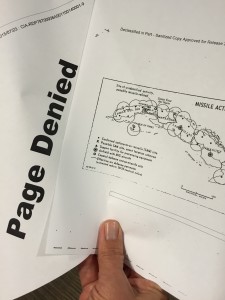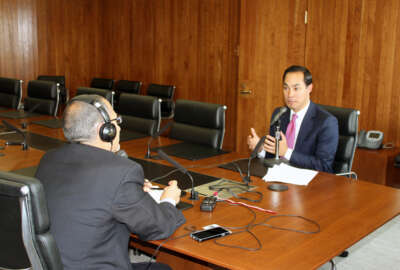CIA gets a B in declassifying Kennedy, Johnson era daily briefs
Latest declassification project lets you see most of what two Presidents held and read from the CIA. But too much is redacted, a half-century later.
Today, it’s delivered on an iPad. But at one time it was neatly typed on seven squarish pages with a spiral binding along the top edge. That’s how President John F. Kennedy received his first daily presidential brief, known initially as the President’s Intelligence Checklist — pickle for short.

Kennedy read his first checklist sitting on the diving board over a swimming pool at his retreat in the Blue Ridge Mountains.
This is all related in a gem of a speech delivered by CIA Director John Brennan Wednesday at the LBJ Presidential Library in Austin, Texas. The occasion was the declassification and public posting of the daily intelligence briefings delivered to Kennedy and to Lyndon Johnson.
Brennan glossed over the often difficult relationship between the White House and the CIA. But the speech was full of delightful anecdotes on the etiology and development of this piece of Americana. The checklist evolved into the Presidential Daily Brief, or PDB, after Johnson because President. His work style and ways of taking in information differed from those of JFK. So the CIA, according to Brennan, redid the checklist into a new format, named it and changed the morning delivery time. LBJ would receive the PDB in the afternoons. He liked to do his reading, pajama-clad in bed, Brennan reported.
The CIA has done a good job in posting the Kennedy’s pickles and Johnson’s PDBs to its website. In this case, if simply lists them chronologically starting with the first one on June 17, 1961. They appear as PDFs, so you can get a sense of how they were produced — the typewriter fonts, the shadow of the binding, the simple formatting. I hope later the CIA or perhaps the LBJ library will put them in a digital, more searchable form.
 I was disappointed at how much is still classified, though. I downloaded the checklist from Oct. 18, 1962, the third day of the Cuban missile crisis. The very first page is totally redacted. But the CIA did release an annotated map of Cuba showing the missile and support facility cites.
I was disappointed at how much is still classified, though. I downloaded the checklist from Oct. 18, 1962, the third day of the Cuban missile crisis. The very first page is totally redacted. But the CIA did release an annotated map of Cuba showing the missile and support facility cites.
We can’t see current PDBs, classified as they are. Brennan said the early ones were saltier and more direct than they are today. No doubt the pervasive and soul-crushing need to avoid frankness and colorful language in favor of the soft, rounded bureaucratese of today has infected the PDB.
In reading the Kennedy-era pieces, I’m impressed by the conversational, everyday tone the writers used. On the same day’s pickle, there’s this item about Saudi Arabia. “King Saud has named Crown Prince Faysal prime minister and given him authority to form his own cabinet — which amounts to forced abdication.”
As early as 1961, Vietnam — then two warring countries — made its way prominently into the brief. Again the direct, clear language. “Severe flooding of the upper Mekong delta will place an additional heavy strain on South Vietnam’s resources. Damage to the rice crop will be particularly serious, as Viet Cong activity has already reduced the rice export surplus for this year from 400,000 to 100,000 tons. On the other hand, the Viet Cong itself has lost heavily in supplies and ‘arsenals’ in this same area.” Accompanied by a map of Vietnam, the CIA provided a concise picture.
Today it takes nearly 10 pages in the densely-packed Federal Register to describe a new Defense Department rule for cloud computing contractors. The latest EPA gambit takes 2,000 pages. What a refreshing blast to see the entire world situation boiled down to so few, brief paragraphs for the Commander in Chief.
Copyright © 2025 Federal News Network. All rights reserved. This website is not intended for users located within the European Economic Area.
Tom Temin is host of the Federal Drive and has been providing insight on federal technology and management issues for more than 30 years.
Follow @tteminWFED
More from Tom Temin:





